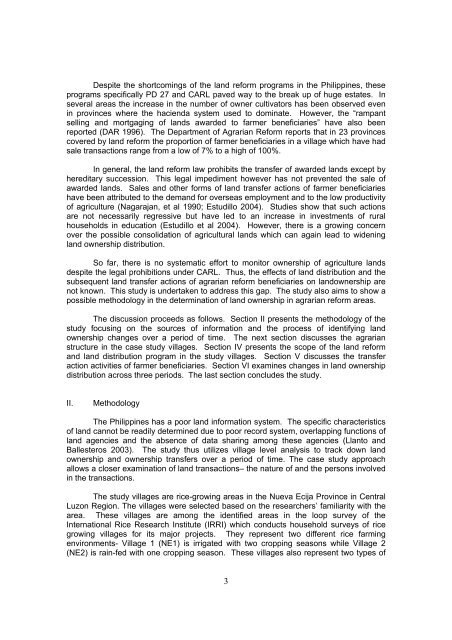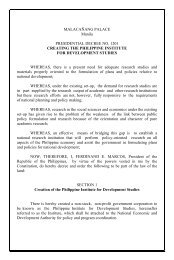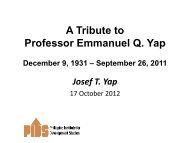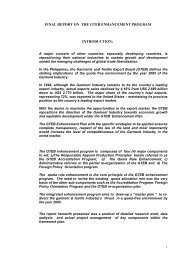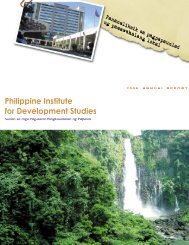being copies comments refinements necessarily
Land Reform and Changes in Land Ownership Concentration ...
Land Reform and Changes in Land Ownership Concentration ...
You also want an ePaper? Increase the reach of your titles
YUMPU automatically turns print PDFs into web optimized ePapers that Google loves.
Despite the shortcomings of the land reform programs in the Philippines, theseprograms specifically PD 27 and CARL paved way to the break up of huge estates. Inseveral areas the increase in the number of owner cultivators has been observed evenin provinces where the hacienda system used to dominate. However, the “rampantselling and mortgaging of lands awarded to farmer beneficiaries” have also beenreported (DAR 1996). The Department of Agrarian Reform reports that in 23 provincescovered by land reform the proportion of farmer beneficiaries in a village which have hadsale transactions range from a low of 7% to a high of 100%.In general, the land reform law prohibits the transfer of awarded lands except byhereditary succession. This legal impediment however has not prevented the sale ofawarded lands. Sales and other forms of land transfer actions of farmer beneficiarieshave been attributed to the demand for overseas employment and to the low productivityof agriculture (Nagarajan, et al 1990; Estudillo 2004). Studies show that such actionsare not <strong>necessarily</strong> regressive but have led to an increase in investments of ruralhouseholds in education (Estudillo et al 2004). However, there is a growing concernover the possible consolidation of agricultural lands which can again lead to wideningland ownership distribution.So far, there is no systematic effort to monitor ownership of agriculture landsdespite the legal prohibitions under CARL. Thus, the effects of land distribution and thesubsequent land transfer actions of agrarian reform beneficiaries on landownership arenot known. This study is undertaken to address this gap. The study also aims to show apossible methodology in the determination of land ownership in agrarian reform areas.The discussion proceeds as follows. Section II presents the methodology of thestudy focusing on the sources of information and the process of identifying landownership changes over a period of time. The next section discusses the agrarianstructure in the case study villages. Section IV presents the scope of the land reformand land distribution program in the study villages. Section V discusses the transferaction activities of farmer beneficiaries. Section VI examines changes in land ownershipdistribution across three periods. The last section concludes the study.II.MethodologyThe Philippines has a poor land information system. The specific characteristicsof land cannot be readily determined due to poor record system, overlapping functions ofland agencies and the absence of data sharing among these agencies (Llanto andBallesteros 2003). The study thus utilizes village level analysis to track down landownership and ownership transfers over a period of time. The case study approachallows a closer examination of land transactions– the nature of and the persons involvedin the transactions.The study villages are rice-growing areas in the Nueva Ecija Province in CentralLuzon Region. The villages were selected based on the researchers’ familiarity with thearea. These villages are among the identified areas in the loop survey of theInternational Rice Research Institute (IRRI) which conducts household surveys of ricegrowing villages for its major projects. They represent two different rice farmingenvironments- Village 1 (NE1) is irrigated with two cropping seasons while Village 2(NE2) is rain-fed with one cropping season. These villages also represent two types of3


